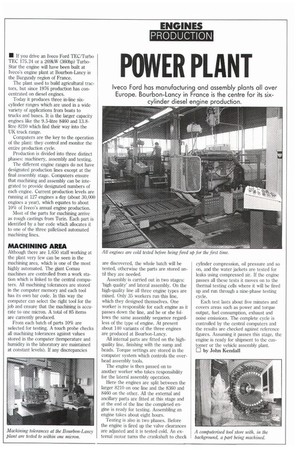POWER PLANT
Page 39

If you've noticed an error in this article please click here to report it so we can fix it.
lveco Ford has manufacturing and assembly plants all over Europe. Bourbon-Lancy in France is the centre for its sixcylinder diesel engine production.
• If you drive an Iveco Ford TEC/Turbo TEC 175.24 or a 269kW (360hp) TurboStar the engine will have been built at Iveco's engine plant at Bourbon-Lancy in the Burgundy region of France.
The plant used to build agricultural tractors, but since 1976 production has concentrated on diesel engines.
Today it produces three in-line sixcylinder ranges which are used in a wide variety of applications from boats to trucks and buses. It is the larger capacity engines like the 9.5-litre 8460 and 13.8litre 8210 which find their way into the UK truck range.
Computers are the key to the operation of the plant: they control and monitor the entire production cycle.
Production is divided into three distinct phases: machinery, assembly and testing.
The different engine ranges do not have designated production lines except at the final assembly stage. Computers ensure that machining and assembly can be integrated to provide designated numbers of each engine. Current production levels are running at 127 engines a day (about 30,000 engines a year), which equates to about 10% of lveco's annual engine production.
Most of the parts for machining arrive as rough castings from Turin. Each part is identified by a bar code which allocates it to one of the three palletised automated machining lines.
MACHINING AREA
Although there are 1,650 staff working at the plant very few can be seen in the machining area, which is one of the most highly automated. The giant Comau machines are controlled from a work station which is linked to the central computers. All machining tolerances are stored in the computer memory and each tool has its own bar code. In this way the computer can select the right tool for the job and ensure that the machining is accurate to one micron. A total of 85 items are currently produced.
From each batch of parts 10% are selected for testing. A touch probe checks all machining tolerances against values stored in the computer (temperature and humidity in the laboratory are maintained at constant levels). If any discrepancies are discovered, the whole batch will be tested, otherwise the parts are stored until they are needed.
Assembly is carried out in two stages: `high quality' and lateral assembly. On the high-quality line all three engine types are mixed. Only 35 workers run this line, which they designed themselves. One worker is responsible for each engine as it passes down the line, and he or she follows the same assembly sequence regardless of the type of engine. At present about 140 variants of the three engines are produced at Bourbon-Lancy.
All internal parts are fitted on the highquality line, finishing with the sump and heads. Torque settings are stored in the computer system which controls the overhead assembly tools.
The engine is then passed on to another worker who takes responsibility for the lateral assembly operation.
Here the engines are split between the larger 8210 on one line and the 8360 and 8460 on the other. All the external and ancillary parts are fitted at this stage and at the end of the line the completed engine is ready for testing. Assembling an engine takes about eight hours.
Testing is also in two phases. Before the engine is fired up the valve clearances are adjusted and it is tested cold. An external motor turns the crankshaft to check cylinder compression, oil pressure and so on, and the water jackets are tested for leaks using compressed air. If the engine passes all these tests it moves on to the thermal testing cells where it will be fired up and run through a nine-phase testing cycle.
Each test lasts about five minutes and covers areas such as power and torque output, fuel consumption, exhaust and noise emissions. The complete cycle is controlled by the central computers and the results are checked against reference figures. Assuming it passes this stage, the engine is ready for shipment to the customer or the vehicle assembly plant. O by John Kendall








































































